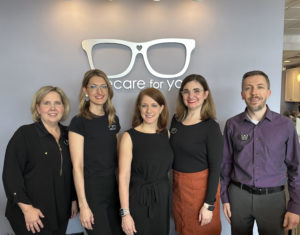
Dr. Ramsey-Foster, center, with her practice team. Dr. Ramsey-Foster says that training, including scripting, helped the practice effectively educate patients about the transition to becoming a direct-care practice that does not accept insurance plans.
By Kara Ramsey-Foster, OD
Feb. 15, 2023
Managed vision care makes being a profitable independent practice a great challenge. In my practice, we are taking what is sometimes referred to as a “direct care” approach. We have eliminated managed care from our practice, and as a result, have significantly increased our revenue-per-exam.
Before going to a direct-care system, we were averaging about $300 in revenue per patient exam, but in our first full year of direct care we had an increase of 50 percent ($450 revenue-per-patient) and we’ve steadily risen over the years. We are currently averaging $564 in revenue per patient exam.
Our cost of goods has improved and the quality of the lenses and products that we’re offering to our patients is better, which means improved patient satisfaction, less chair time and fewer remakes.
Here is why and how we moved to direct care.
The Vision of Direct Care Approach
Direct care started in the field of primary care as a mode of practice in which patients pay their physician directly in the form of a monthly fee or annual fee in order to have better access to their doctor. In eyecare, I use a fee-for-service system where patients pay my office directly, with no involvement of the insurance company. It’s “direct care” because it’s a direct relationship between doctor and patient without the insurance middleman. It allows me more quality time with my patients. The overall goal is to provide patients the best possible care.
Direct care helps to improve relationships between doctor and patient to establish trust. Research shows that increased education and communication from the doctor increases patient understanding, trust and engagement.1 This can increase adherence to recommendations and lead to better self-care skills, which, in turn, positively affects health and well-being.
Direct care is a pathway through which communication can lead to better overall health due to increased access to care, greater patient knowledge and shared understanding, higher-quality medical decisions, improved therapeutic cooperation, increased social support and empowerment and better management of emotions.
Create Scripts for Your Staff To Answer Patient Questions & Concerns
When we moved to a direct-care system, I didn’t personally know anyone else in eyecare doing it. I knew that it was being done successfully in primary care, but I wanted to see if we could make that change in eyecare to operate as a fee-for-service system.
Direct care is a new mode of practice, especially for eyecare, so making sure that staff is trained to explain direct care to patients is the most important thing. We’re asking patients to pay out-of-pocket and wait for their insurance to reimburse them, so we want to make sure we’re not only explaining why it will be a benefit to them, but also exemplifying that benefit when they are in the office.
Other Articles to Explore
I started about six months out, writing my scripts and training my team on how to explain a direct-care system to patients. We notified the insurance companies that we were going out of network and revamped our pricing to make it more fair, across-the-board pricing.
We emphasize quality care and make sure our team is trained to explain and exemplify that. Here are examples of some of the common patient questions and complaints we trained our staff to answer:
“Why don’t you take my insurance?”
Staff: “We are a direct-care practice, which means that we are able to provide a higher quality of care by working with you directly, rather than through an insurance provider, which may not have your best interests at heart. The way it works is you will pay us in full at your appointment. We then will help you submit a request for reimbursement to your insurance provider. We find that most of our patients are reimbursed for some, or all, of their appointment with us.”
“I think I’m just going to find an eye doctor who accepts my insurance”
Staff: “We definitely understand why would want to do that. I want you to know, though, that one of the advantages of not working through insurance providers is that we are able to spend more time with each of our patients since we are not working on a patient-volume basis. In our office, it’s all about quality rather than quantity of appointments. We also are not forced to work only with certain frame and lens and glasses-making labs. That means that you know you are only getting the best products and services from us, rather than the products and services that an insurance company wants us to give you. So, you see that there are many advantages you won’t find in those other practices that we can offer because of this very different approach we take.”
“Will I still be able to get a nice pair of glasses?”
Staff: “Definitely! We have a range of frames in our optical and many lens choices. That’s one of the great things about not having to worry about working with an insurance company. We can sell any products we choose, which means a wider range of options for you. I bet we can work with you to find just the glasses you have in mind.”
As patient questions come in, we continue to fine-tune our responses and the information we proactively provide–ideally before the patient even thinks of the question or concern.
Our system for scripting to answer direct-care concerns has been so successful, I have created a training program and toolkit for other practices to access: www.directcaredifference.com/courses/direct-care-kit/
Direct Care Creates a Happier Team & Happier Patients As a Result
It’s been an evolving process of how to showcase friendliness and customer service, but I think it starts with a strong team that is happy to come to work and works together seamlessly. Direct care means a smaller, more personalized office, so it’s important to have a team that works together well and truly wants to help patients.
With direct care, it’s easier to have genuinely friendly patient interactions. We feel like a family at my office, and that comes through to our patients. My team is kind and happy, and willing to help patients. It’s smaller scale, personalized care. Patients trust you and it feels like you’re really helping them. You’re able to get to know them and their families. It feels like you’re taking care of friends. Patients come to see you because they like you and appreciate you, and you’re happy to see them too. It’s a happier, more connected relationship.
A direct-care system can improve your day-to-day happiness by taking the stress out of selling products and feeling like you’re having to nickel and dime, which helps create a happier team, happier patients and a better day overall.
References
1. https://www.ncbi.nlm.nih.gov/pmc/articles/PMC3096184/
 Kara Ramsey-Foster, OD, is the owner of EyeCare for You in Apex, N.C. To contact her: drkara@directcaredifference.
Kara Ramsey-Foster, OD, is the owner of EyeCare for You in Apex, N.C. To contact her: drkara@directcaredifference.





















